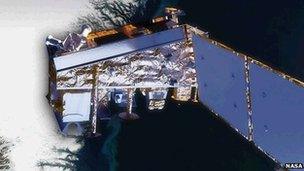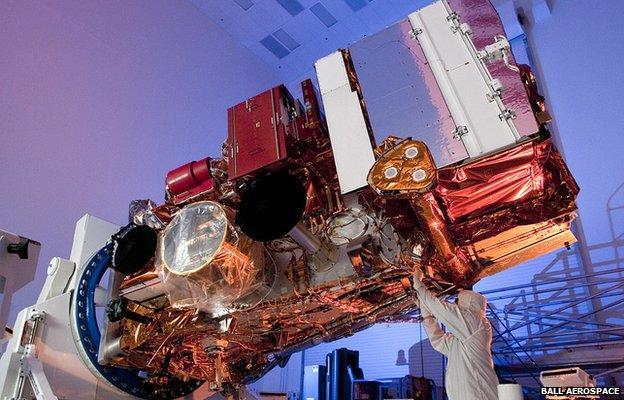NPP weather and climate satellite launches
- Published
The launch is something of a preview of the next-generation JPSS fleet of satellites
The US has launched NPP, its $1.5bn (£0.9bn) next-generation weather and climate satellite.
NNP rode into its polar orbit on a Delta II rocket, lifting away from the Vandenberg, California, spaceport at 02:48 local time (09:48 GMT).
The two-tonne satellite has some onerous tasks ahead of it.
NPP must test new-style Earth observing instruments while at the same time providing operational data to meteorologists for general forecasting.
The satellite is a joint effort between US space agency Nasa and the National Oceanic and Atmospheric Administration (Noaa), with input from the Department of Defense.
It has five instruments on board that will monitor a wide range of land, ocean, and atmospheric phenomena - from the temperature and humidity of the air, to the spread of algal blooms in the ocean; and from the amount of sunlight bouncing off clouds to the extent of Arctic ice.
Circling the globe at an altitude of 824km, NPP will become a key sentinel for watching over a changing Earth.
Dr Jim Gleason, the NPP project scientist at Nasa's Goddard Space Flight Center, commented: "NPP's observations will produce long-term datasets which will help scientists make better models, which then lead to better predictions, which hopefully can be used to make better decisions."
"These decisions can be as simple as 'do I need to bring an umbrella?', or as complex as 'how do we respond to a changing climate?'."
Global coverage
There is a concern, however, that NPP is being asked to do too much.
Its climate role requires it to continue datasets acquired over the past 10 years by Nasa's highly successful Earth Observing System satellites - Aura, Aqua, and Terra.
But NPP must also bridge the gap between Noaa's existing system of polar-orbiting weather satellites (the latest is Noaa-19) and the agency's future fleet, known as the Joint Polar Satellite System (JPSS).
"The NPP mission design life is five years; it has propellant in its propulsion system for seven years," explained Scott Asbury from Ball Aerospace and Technologies Corporation, which built NPP.
"Nasa is concerned about the longevity of the instruments on board. They were built to prove the instruments in the future operational system, and there were some anomalies in the development of the instruments that had to be overcome," he told BBC News.
"Noaa's target date for launching JPSS-1 is the first quarter of 2017. So they're worried NPP won't last long enough to get JPSS-1 up on orbit and fully commissioned."

Among its diverse tasks, the NPP satellite will monitor the state of Arctic ice
The US has geosynchronous weather satellites that sit 36,000km above the planet, but these cannot deliver some of the high-resolution atmospheric information that meteorologists need to make their forecasts.
America shares its weather data with the likes of Europe, which flies its own polar-orbiting satellite system known as Metop.
The European spacecraft crosses the equator in the morning, local time, and NPP will cross the equator in the afternoon, providing the fullest picture of what is happening on Earth throughout the day.
The loss of NPP before a replacement is flying would therefore be a blow to weather forecasting and climate studies on both sides of the Atlantic.
Dr Louis Uccellini, who directs Noaa's National Centers for Environmental Prediction, said NPP's importance was underscored by events in 2011, which he described as "the year of the billion-dollar weather disasters".
"We've already had 10 separate weather events [in the US], each inflicting at least $1bn in damages, including the tornado outbreaks, fires, hurricanes that have affected the East Coast of the US, and floods that have affected a large portion of the north-central US.
"With NPP's advanced microwave, infrared and visible data feeding Noaa's operational weather prediction models, we expect to improve forecasting skills and extend those skills out to five to seven days in advance, for hurricanes and other extreme weather events."
NPP stands for National Polar-orbiting Operational Environmental Satellite System Preparatory Project.
It was born out of a failed attempt to unify the US civilian and military polar orbiting weather satellite systems. That joint effort was blighted by delays and cost overruns, and was eventually dismantled in 2010. Nasa and Noaa are now pursuing their JPSS project to maintain the 30 civilian datasets that NPP will produce.

NPP has been built by Ball Aerospace. The company will also prepare JPSS-1
- Published10 June 2011
- Published4 March 2011
- Published25 February 2011
- Published22 June 2010